Farheen Bano1, Mohammad Arif Kamal2
1Faculty of Architecture, Dr, A.P.J. Abdul Kalam Technical University, Lucknow, India
2Architecture Section, Aligarh Muslim University, Aligarh, India
Correspondence to: Mohammad Arif Kamal, Architecture Section, Aligarh Muslim University, Aligarh, India.
| Email: |  |
Copyright © 2016 Scientific & Academic Publishing. All Rights Reserved.
This work is licensed under the Creative Commons Attribution International License (CC BY).
http://creativecommons.org/licenses/by/4.0/

Abstract
A building envelope is the physical interface between the conditioned i.e. inside and unconditioned i.e. outside environment of a building. As India has a tropical climate, heating or cooling is required throughout the year to make indoor environment comfortable. By designing envelope according to the climate, making suitable material choices, fenestration and shading devices sizes, the load on the mechanical heating and cooling can be reduced. This paper reviews the various components of building envelope and its effect on annual heating and cooling loads of the office buildings in various climatic zones of India. It also recommends the various design considerations to be preferred while designing envelope of office buildings.
Keywords:
Energy efficient buildings, Building envelope, Office buildings, Climate responsive architecture, India
Cite this paper: Farheen Bano, Mohammad Arif Kamal, Examining the Role of Building Envelope for Energy Efficiency in Office Buildings in India, Architecture Research, Vol. 6 No. 5, 2016, pp. 107-115. doi: 10.5923/j.arch.20160605.01.
1. Introduction
Energy is a basic requirement for economic development in almost all major sectors of Indian economy - agriculture, industry, transport, commercial, and residential. In India, 29% of the total energy is used by the buildings, out of which 20% by residential and 9% commercial as shown in Figure 1. Commercial buildings are one of the major consumers of energy and are the third largest consumers of energy, after industry and agriculture. The absolute figure is rising fast, as construction booms, especially in developing countries such as India. Currently, approximately 659 million m² spaces is used as commercial space and in 2030, it is estimated that it would increase to 1,900 million m² and by then more than 60% of the commercial built space would be air conditioned as shown in Figure 2. [1]  | Figure 1. Break down of energy consumption pattern in India. [2] |
 | Figure 2. Annual growth of commercial buildings in India. [1] |
The energy conscious design approach helps designers and building owners to economically reduce building operating costs, while improving comfort for the building’s occupants. The energy consumed by a building depends on its use (whether residential, commercial or industrial), the type of building (air-conditioned or non air condition, and the climate. Architects have to ensure that the design of the built form suits the intended use of the building and the specific needs of the client within the framework of the prevailing climatic conditions.
2. Demand of Office Buildings in India
Commercial Buildings are divided into various sub categories i.e. offices, hotels, hospitals and shopping Centres or Malls. Above all the mentioned commercial space demand, the office space demand is high due to increasing share of the services sector in the Indian economy as office space supply shifting from central business Districts to secondary centres (office and IT parks). Modern office buildings are coming up or likely to built in newly developed area for IT services. In India, 70% offices are of services companies (more than 7000 No.), 15% by financial and pharmaceutical sector and 15% by other sectors. Overall, demand for Grade A office space in the top seven cities of the country rose 18% to touch an all-time high 38 million square feet in 2015, compared to a year earlier, property consultancy firm CBRE said in its India Office Market View report. [3]
3. Role of Building Envelope in Energy Saving
Most of the commercial buildings have energy performance index (EPI) of 200 to 400 kWh/ sq m/ year. Energy-conscious building design has been shown to reduce EPI to 100 to 150 kWh/ sq m/ year in India [4]. The potential for energy savings is 40 – 50% in commercial buildings, if energy efficiency measures are incorporated. In commercial buildings, the energy consumption pattern is shown in Fig. 3.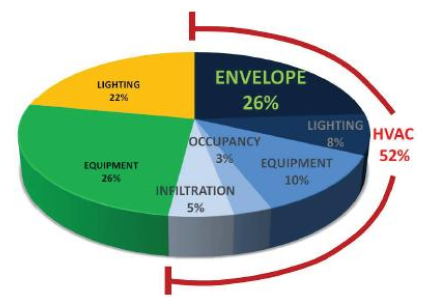 | Figure 3. Break down of energy consumption of commercial building pattern in India. [2] |
HVAC accounts for the highest energy consumption in the Commercial buildings. The load on HVAC is basically through the internal heat gain which is through building envelope, lighting, equipments, occupancy and infiltration. Out of 52 percentage load from the HVAC, 26 percent is the load from heat gain through building envelope. In a commercial building, the cooling load can be saved by adopting appropriate design considerations and operation strategies for building envelope. Simple design procedures such as orientation, shading, insulation, etc. can be easily incorporated in any building, leading to substantial benefits from the point of view of comfort and energy savings.
4. Building Envelope
According to Brock [5], the building envelope is the skin of a building which is supported by the skeleton of the building structure. It acts as a thermal barrier between the enclosed conditioned space and outside environment through which the thermal energy is transferred. By minimizing the heat transfer through the building envelope the need of energy used for space heating and cooling can be reduced considerably. Hence by judicially designing the building envelope parameters i.e. orientation, shape, walls, fenestrations, shading device and roof, the HVAC load can be reduced in commercial buildings.
5. Climatic Zones in India
Building Energy consumption is climate dependant. According to ASHRAE 90.1 [6]. India comes under the climatic zone-1, mostly hot & dry or hot & humid all year round. It is further sub divided as shown in the Table 1 and figure- 4. [7] The building should be designed according to the climate, such that there is thermal comfort inside the building. According to the ASHRAE 55 [8], thermal comfort is defined as “that condition of mind which expresses satisfaction with the thermal environment and is assessed by subjective evaluation.” Thermal comfort is essential to consider when designing a structure that will be occupied by people. Thermal criteria according to ASHRAE 90.1 [8] is based on HDD65 (Heating degree days, base 65°F) and CDD50 (Cooling degree days, base 50°F). For India CDD50 is greater than 9000, hence cooling is required all year round. CDD50 and HDD65 for New Delhi is 10,060 and 480 respectively. For Indian climate, the comfort range of still air corresponds to 72-105 ºF dry bulb temperature with 30– 60% relative humidity. Beside these various other climatic elements such as wind speed, vapour pressure and radiation also affect the comfort conditions.Table 1. Climatic Zones of India [7]
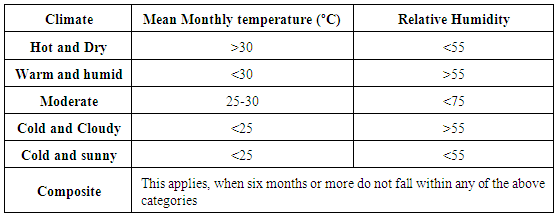 |
| |
|
 | Figure 4. Climatic Zone Map of India [7] |
The building envelope should be designed according to the climate to achieve the energy efficiency in the building. Various building envelope parameters are discussed below and how they affect the thermal transfer inside the building, while considering the cities in the different climatic zones and also suggest the recommendations for that parameter.
6. Orientation
Orientation of buildings is the major design consideration with regards to solar radiation, daylight and wind. The best orientation requires that the building as a whole should receive maximum solar radiation in winter and minimum in summer. To decide on an optimum orientation, it is essential to have an idea of the sun’s position through sun path diagram and prevailing wind directions (Figure 5). Once the orientation is decided, the heat entering a building can be controlled by area and type of glazing, types of walls and roofs, and shading.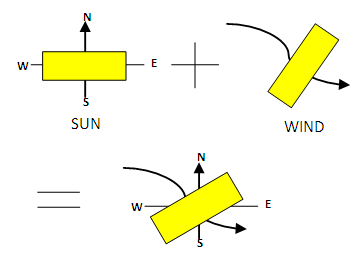 | Figure 5. Orientation of building according to sun and wind |
To illustrate the effect of orientation, a rectangular conditioned building was considered by Nayak and Prajapati [9], having fully glazed wall on one of its long sides. They consider four orientations such as northwest-southeast, north-south, northeast-southwest and east-west of that building with respect to its long axis. They estimated annual cooling load of that a conditioned building in a Indian cities in different climatic zones is shown in Figure 6. It is seen that in warm climates, the maximum load corresponds to the northeast-southwest orientation hence it should be avoided.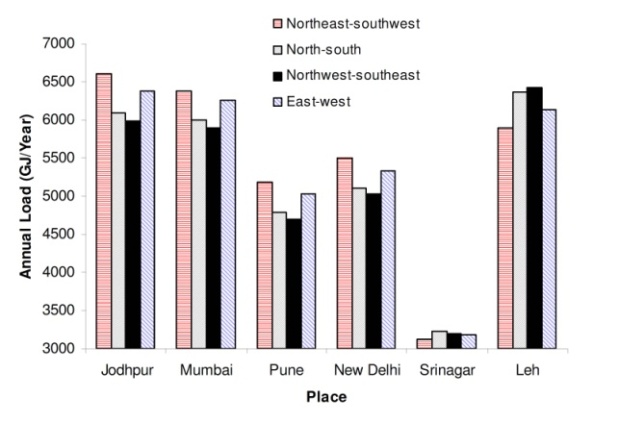 | Figure 6. Effect of Orientation on annual Load of a conditioned building in various cities. [9] |
Configuring the geometry of the building appropriate to the climate and usage can control the magnitude of the heat flow. The heat flow due to radiation and air movement can be controlled by varying the following aspects of the building configuration.
7. Surface Area to Volume Ratio and Shape of the Building
The ratio of the surface area to the volume of the building (S/V ratio) determines the magnitude of the heat transfer in and out of the building for minimum heat transfer lower S/V ratio is required.The aspect ratio should be one to minimize the heat transfer as it has minimum S/V ratio. According to The handbook for planning of office buildings [10], the daylight can travel in the interior spaces up to 7m, hence considering the suitable orientation, surface area to volume ratio and daylight, the aspect ratio of office buildings should be 1:2 as shown in Table 2. | Table 2. The heat gain through various building elements on the cooling load of a ground + 4 storeyed office building for some cities of India. [9] |
8. Building Components
The nature of a building envelope determines the amount of radiation and wind that will enter the building. It consists of walls, fenestrations and roof. The heat flow through these elements is characterised by their resistance, thermal capacity, absorption, transmission and emission. The materials for these components have to be chosen carefully depending on specific requirements. The heat gain or loss through individual elements depends on whether the building is single storeyed or multi-storeyed. In a single storeyed building, maximum heat gain occurs through the roof, whereas in a multi-storeyed building it is through the walls and windows as shown in Figure 7. 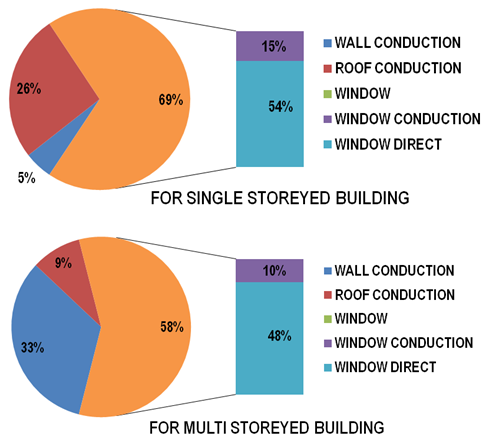 | Figure 7. Heat Gain through various Building Envelope components |
The heat gain through various building elements on the cooling load of a ground + 4 storeyed residential building for some cities of India was being examined by Nayak and Prajapati [9] and the reading are given in Table 3. From the table it is clearly visible that maximum cooling load is from window and then from wall and roof in the multi storeyed building. Offices are generally multi storeyed hence the cooling load can reduce by energy efficient measures for components of building envelope.Table 3. Opaque Wall Assembly U-Factor and Insulation R-value Requirements [11]
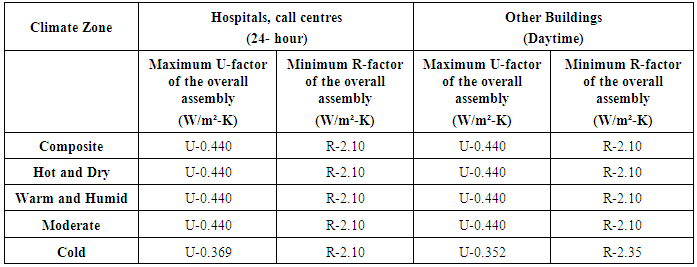 |
| |
|
8.1. Wall
Walls constitute a major part of the building envelope and receive a large amount of direct solar radiation. The resistance to heat flow through the exposed walls may be increased by increasing the thickness (thermal mass), through cavity wall, by the use of insulating material or by applying light coloured whitewash or distemper on the exposed side of the wall. As per Energy Conservation Building Code (ECBC) [11], recommended U Value wall assembly for 24 hour use building and for daytime use building are given in Table 4.Table 4. R-values of few Insulating materials [13]
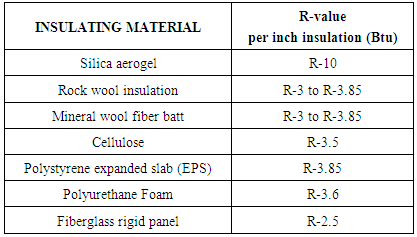 |
| |
|
According to ECBC [12] the recommended U-value is 0.440 and the R-value is 2.10. Various wall assemblies are shown in Fig-8 from normal single 9 inch brick wall to double wall with air gap and insulation and their respective U-value and Table 5 shows the R-value of various insulation materials whose R-value is greater than 2.1. By using Double wall with insulating materials the heat transfer can be reduced in office buildings.Table 5. Roof Assembly U-Factor and Insulation R-value Requirements [11]
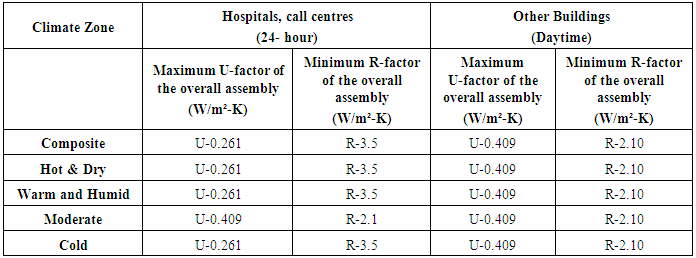 |
| |
|
 | Figure 8. U-value of wall assembly (W/m²-K) [12] |
8.2. Roof
The roof of a building receives a significant amount of solar radiation. Thus, its design and construction play an important role. The heat gain through roofs may be reduced by the use of insulating materials may be applied externally or internally to the roofs. Shining and reflecting material may be laid on top of the roof. Roofs may be flooded with water in the form of sprays or in other ways. Loss due to evaporation may be compensated by make-up arrangement. Movable covers of suitable heat insulating material, if practicable, may be considered. White washing of the roof can be done before the onset of each summer.According to ECBC the recommended U-value of roof assembly should be 0.261 and the R-value 2.10 for 24-hour use building and 0.409 and the R-value 2.10 for daytime use building. Typical roof assembly of RCC slab with insulation us shown in Fig-9. Table 6 shows the roof assembles that can be used for achieving U- value greater than 0.409. 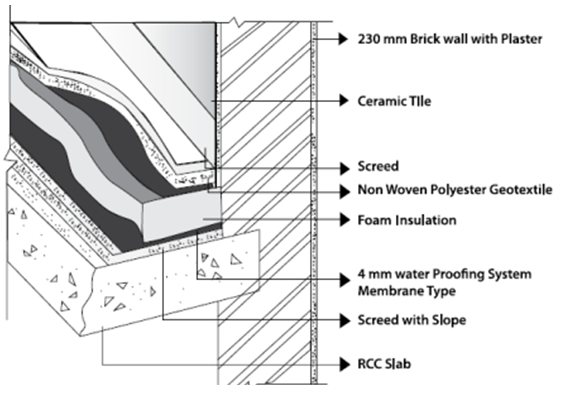 | Figure 9. Typical Insulation Technique for RCC roof construction [11] |
Table 6. R-values of few roof assemblies [14]
 |
| |
|
8.3. Fenestration
Fenestration is provided for the purposes of heat gain, day lighting and ventilation. Appropriate design of openings and shading devices help to keep out sun and wind or can also allow them into the building. Glass is transparent to solar radiation but opaque to long wave radiation. This characteristic can be used to heat a building interior by promoting heat gain. ECBC recommends maximum Wall window Ratio (WWR) less than 60% and Table 7 shows the recommended values of U-factor and Solar Heat gain Coefficient (SHGC) of the fenestration for two WWR ranges.In exposed windows and doors, suitable methods should be adopted to reduce both direct solar heat gain and heat transmission. It can be achieved by the use of shading devices such as vertical louvers and horizontal projections and heat resistant glazing.Table 7. U-Factor and SHGC requirement for fenestrations [10]
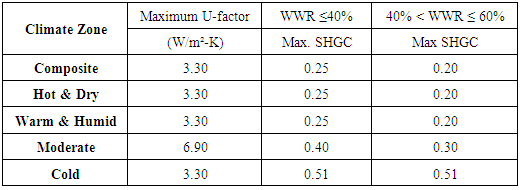 |
| |
|
8.3.1. Shading
Nayak and Prajapati [9] recorded the yearly beam radiation incident on a typical window of size 1.2m X 1.2m having different external shading devices (horizontal and vertical) in some cities of India presented in Figure 10. The graphs shows how the shadings devices help in reducing the radiations entering the building through fenestrations drastically. 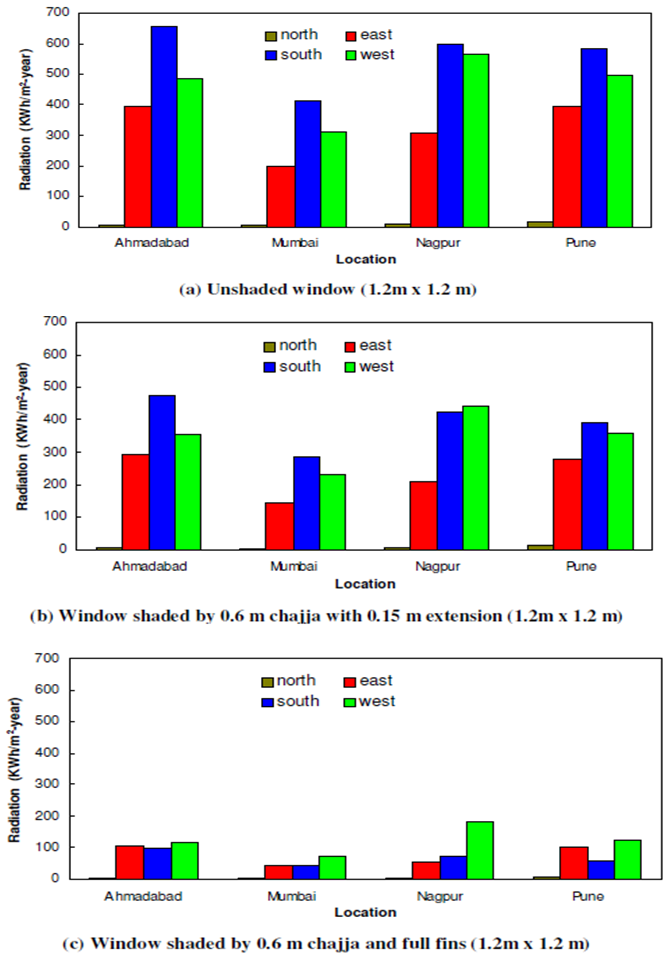 | Figure 10. Effect of Shading on thermal load. [9] |
8.3.2. Glazing
Use of double or triple glasses with air space in between the direct transmission of solar radiation can be reduced. Reflective Glazing can reduce heat gain without obstructing viewing. They are usually used for windows which cannot be shaded externally. Figure 11 shows the double glazing assembly of clear glass, Low E value glass and tinted glass respectively. The U factor and SHGC of Low-E glass is minimum and visible light Transmittance (VT) is also high, hence recommended for office buildings.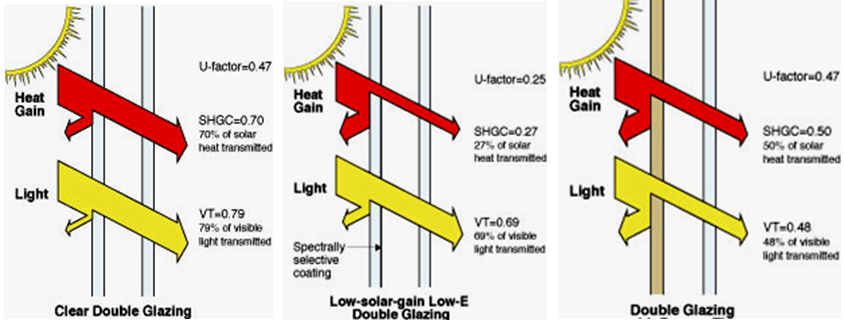 | Figure 11. Types of Glazings assemblies [13] |
9. Conclusions
There is vast potential of energy saving through efficient design of building envelope design for office buildings in India. This paper highlights the fact that different components of building envelope have different energy saving potential. Recommended orientation according to sun and wind is northwest and south east and shape of the office building should be rectangular with aspect ratio 1:2 and width 15m, so that heat transfer into interior is minimum while taking the advantage of daylight maximum. Walls and roofing should have insulation to reduce HVAC load in office buildings. Fenestrations should have vertical and horizontal shading devices and double glazing window with low-e value glass should be used. By incorporating all the parameters the energy saving potential ranges would be as high as ranging from 17 to 42%.
References
| [1] | Kumar, Satish. Benchmarking Energy Use in Buildings and Cleanrooms. Bangalore : ISA Vision Summit, 2011. |
| [2] | Central Electricity Authority's 'Year End Review 2012-13. New Delhi: CEA, MoP, GOVERNMENT OF INDIA, Retrieved from www.cea.nic.in/reports/yearly/annual_rep/2012-13/ar_12_13.pdf, 2013. |
| [3] | CBRE. CBRE: India Office Marketview - Q1 2015. CBRE India. [Online] April 2015. [Cited: september 5, 2016.] http://www.cbre.co.in/aboutus/mediacentre/mediaarchives/Pages/Office-space-take-up-witnesses-46-rise-in-Q2-2016-over-Q1-2016-.aspx. |
| [4] | Kumar, Satish. Benchmarking Energy Use in Buildings and Cleanrooms. Bangalore : ISA Vision Summit, 2011. |
| [5] | Brock, L. Designing the exterior wall: an architectural guide to the vertical envelope. Hoboken : John Wiley, 2005. |
| [6] | ASHRAE 90.1. ANSI/ASHRAE/IES Standard 90.1, Energy Standard for Buildings except low rise residential Building. Atlanta : ANSI/ASHRAE/IES, 2013. |
| [7] | National Building Code (NBC), India, 2005. |
| [8] | ASHRAE 55. ANSI/ASHRAE standard 55, Thermal environmental conditions for Human Occupancy. Atlanta : ANSI, 2010. |
| [9] | Nayak, J.K. and Prajapati, J.A. Handbook on enegy conscious buildings. New Delhi : Solar Energy Centre, MNES, Govt. of India, 2006. |
| [10] | CPWD. A handbook for planning of office buildings. New Delhi : Directorate General, CPWD, 2013. |
| [11] | ECBC User Guide v 2.0. Energy Conservation Building Code. [Online] Aril 01, 2011. [Cited: 6 2015, 16.]http://www.eco3.org/wp-content/plugins/. ECBC User Guide v 2.0. |
| [12] | Bengali, Abdulkader. Developing energy effiecient building envelope. s.l. : Ownes Corning, 2009. |
| [13] | Wikipedia. R-value (insulation). Wikipedia. [Online] 2014. [Cited: september 9, 2016.] https://en.wikipedia.org/wiki/R-value_%28insulation%29. |
| [14] | Development of Building Regulations and Guidelines to achieve energy effieciency in Banglore city. TERI. [Online] 2010. [Cited: February 10, 2014.] http://www.teriin.org/ResUpdate/reep/ch_1.pdf. |
| [15] | Electric Power Demand Forecasting: A Case Study of Lucknow City. Bhardwaj, A.K. and Bansal, R.C. 2011, Research Journal of Applied Sciences, Engineering and Technology 3(3), pp. 149-152. |
| [16] | Abdulkalam, APJ. Energy independence and evolution of carbon neutral nations-. indiandefence.co. [Online] September 29, 2012. [Cited: November 1, 2013.] Retrived from http://indiandefence.com/threads/energy-independence-and-evolution-of-carbon-neutral-nations-apj-abdulkalam.21774/. |
| [17] | Krishnan, Arvind, et al. Climate Responsive Architecture-A design Book for energy efficient buildings. New Delhi: Tata McGraw Hill Publishing Complany, 2001, p. 100. |
| [18] | SP: 41, S&T. Handbook on functional requirements of buildings,. New Delhi : Bureau of Indian, 1987. |
| [19] | TOI, Lucknow. Chak Gajaria farm land use changed. Times of India. [Online] June 8, 2013. [Cited: June 20, 2015.] http://timesofindia.indiatimes.com/city/lucknow/Chak-Gajaria-farm-land-use-changed/articleshow/20485757.cms?referral=PM. |
| [20] | Building envelope Optimization using Emergy Analysis. Srinivasam, Ravi S., et al. Sydney : Proceedings of Building Simulation 2011, 14-16 November, 2011. 12th Conference of international Building Performance simulation association. pp. 358-365. |
| [21] | Parametric Analysis of energy Efficient Building Envelope in Thailand. Chungloo, S, Limmeechokchai, B and Chungpaibulpaya, S. 2001, Asaian J. Environ. Vol.2 Issue 2, pp. 125-143. |
| [22] | Genetic-algorithm based approach to optimize building envelope design for residential building. Tuhus-Dubrow, Daniel and Krarti, Moncef. 2010, Building and Environment 45, pp. 1574-1581. |
| [23] | Energy Efficiency Towards Building Envelope An Analysis Study Between Main Library of University Malaya Building and Library of UiTM Perak Building. Zafirol, Anas and A.H, Al-Hafzan. 2010, International Journal of Environmental Science and Development, Vol. 1, No. 2. |
| [24] | Nayak, J.K. and Hazra, R. Development of design guidelines on solar passive architecture and recommendations for modifications of building bye-laws, Final Report, R & D Project no. 10/86/95-ST,. 1999. |















 Abstract
Abstract Reference
Reference Full-Text PDF
Full-Text PDF Full-text HTML
Full-text HTML




